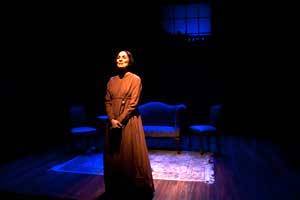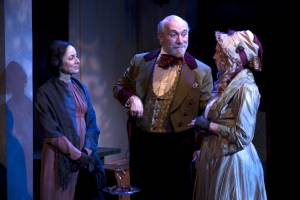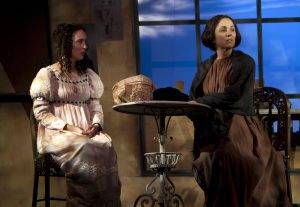
Who would ever have thought that a 164-year-old French novel would provide the basis for the juiciest, funniest, most twisted 3-act, 3-hour family saga since Tracy Letts’ August Osage County? But that’s precisely what Jeffrey Hatcher’s delicious adaptation of Honoré de Balzac’s Cousin Bette has turned out to be, particularly under the brilliant direction of Jeanie Hackett and as performed by the superb troupe of actors who make up the Antaeus Company, “L.A.’s Classical Theater Ensemble.”
La Cousine Bette, for those unfamiliar with the Balzac original, tells the tale of Lisbeth (aka Bette) Fischer, cursed with the bad luck to be the poor, unattractive, and still-single-at-42 relation of a wealthy (and generally quite good-looking) French family called the Hulots. Balzac describes Bette as “lean, brown, with … thick eyebrows joining in a tuft … and some moles on her narrow simian face.” Thankfully, Nike Doukas (Bette at the performance reviewed here, all roles having been double-cast) spares us the tuft and the moles. Still, the stunning-in-real-life actress has been sufficiently plained down to make us believe that she is indeed an ugly duckling unlikely to turn into a swan at any foreseeable point in the future.
Bette’s litany of family resentments finally reaches the breaking point when her beauteous cousin Hortense (Kellie Matteson) announces her engagement to the (pardon the anachronism) movie-star handsome Wenceslas Steinbock (Daniel Bess), a down-on-his-luck aristocratic Polish sculptor whom Bette has nursed back to health following a failed suicide attempt.
Cousin Bette is aided and a-Bette-d in her schemes by her glamorous neighbor Valerie (Jen Dede), an abused wife with a fortuitous talent for attracting men like moths to a flame. Before long, Valerie has bedded Hulot patriarch (and serial philanderer) Hector (Barry Creyton) and Hulot family friend Crevel (Tony Amendola), extracting considerable sums of money from each, and thereby setting the two men off on their Bette-inspired road to ruin. At the same time, Bette continues to nurse her unrequited love for Wenceslas in the vain hope that someday, when the family of his beloved Hortense has been destroyed, she will be able at last to change out of her one ugly dress and into a slinky black sheath, apply some instant-makeover make-up, and quickly restyle her frumpy hairdo into a wavy glamour-do—thereby convincing Wenceslas that the right woman has been in front of his eyes all along.
Sorry Bette. Think again.
Playwright Hatcher has taken a few liberties in condensing Balzac’s nearly 600-page novel to a three-hour play (that’s including two ten-minute intermissions), but his adaptation remains remarkably faithful. Where Hatcher adds his own touches is in the wicked humor that makes Cousin Bette one of the funniest melodramas ever, not one of its laughs unintentional.
It helps that Hackett has directed her sensational cast to play it absolutely straight, with nary a hint of overacting. Bette’s fervid declarations of love and screams of betrayal are absolutely real, especially in the gifted hands of the ever surprising Doukas.
There’s not a weak link in the ensemble reviewed here, nor would I imagine, are there in the alternate cast headed by the wonderful Alicia Wollerton as Bette. From Amendola’s slippery Crevel to Emily Chase’s always forgiving Adeline to Matteson’s pampered Hortense to Creyton’s narcissistic Hulot, this is one magnificent bunch of actors.
As Wenceslas and Valerie, Bess and Dede have both the looks to convince us that women and men would easily fall at their feet and the acting chops to make us believe in their absolute sincerity.
Bill Brochtrup has great fun with a pair of diametrically opposed characters, the foppish Victor Hulot and the dastardly Monsieur Marneffe, Valerie’s abusive mate. Other winning performances include Robert Pine’s as Marshal Hulot, Paul Willson’s as Old Fischer, and Mirron Willis’s as the darkly dangerous Demontes.
Completing the cast in terrific fashion are Alexandra Goodman, Aaron Lyons, Janan Raouf, Benny Wills, and Nicol Zanzarella-Giacalone, playing a variety of roles and swiftly moving furniture, props, and a revolving wall to transform Tom Buderwitz’s marvel of a set into the play’s multiple locales.
Speaking of which—students of theater design could get no better lesson than by simply observing Buderwitz’s ingenuity in managing to fit an attic, a pair of balconies, and a dozen or so pieces of period furniture onto Deaf West Theatre’s small, square stage. Depending on the position of the aforementioned revolving wall, the set can represent either the Hulots’ elegant apartment, or Bette’s dingy flat, or Valerie’s modest but stylish digs. Leigh Allen’s superb lighting aids in the switches from poverty to wealth, as do Darcy Prevost and Jen Prince’s detailed props. A. Jeffrey Schoenberg’s 1830s costumes are perfection, as is Sarah Hatten’s wig and hair design—all very Pride And Prejudice, but in a considerably darker setting. Finally, sound designer extraordinaire Cricket S. Myers has underscored the many plot twists and turns with a flawlessly selected medley of themes by Balzac contemporary Frédéric François Chopin.
Hatcher’s adaptations of The Turn Of The Screw and Dr. Jekyll And Mr. Hyde, with their scaled-down casts and somber tones, did not prepare me for the rollercoaster ride of lust, intrigue, and revenge that is Cousin Bette. More delectable than any day-or-nighttime soap and more riveting than just about anything else you’re likely to see this year, Cousin Bette makes for an absolutely triumphant opener of Anateus’s first full season ever. Whether you’re a fan of the classics or wouldn’t pick up a nineteenth century novel if your life depended on this, it’s a sure Bette that you will love Cousin Bette.
The Antaeus Company, Deaf West Theatre, 5112 Lankershim Blvd., North Hollywood.
www.antaeus.org
–Steven Stanley
February 20, 2010
Photos: Michele K. Short





 Since 2007, Steven Stanley's StageSceneLA.com has spotlighted the best in Southern California theater via reviews, interviews, and its annual StageSceneLA Scenies.
Since 2007, Steven Stanley's StageSceneLA.com has spotlighted the best in Southern California theater via reviews, interviews, and its annual StageSceneLA Scenies.







 COPYRIGHT 2024 STEVEN STANLEY :: DESIGN BY
COPYRIGHT 2024 STEVEN STANLEY :: DESIGN BY